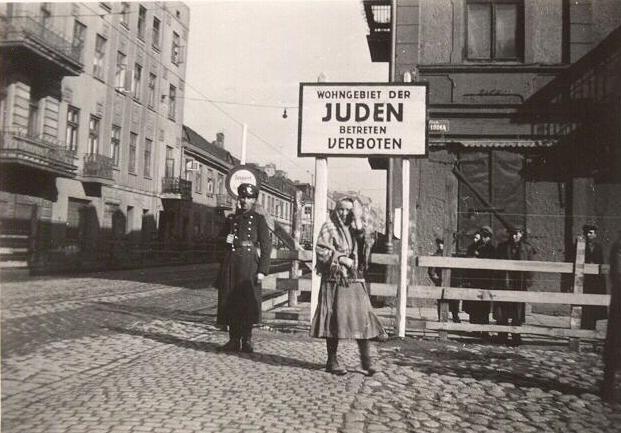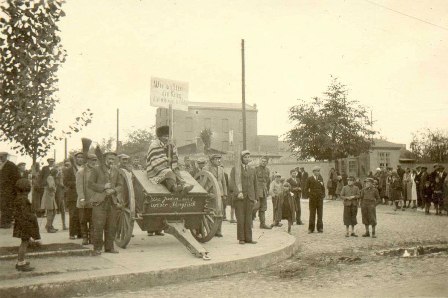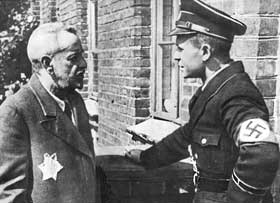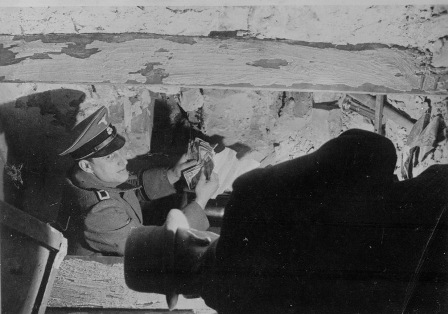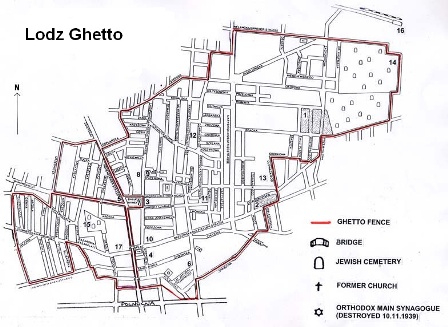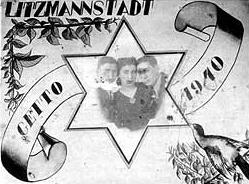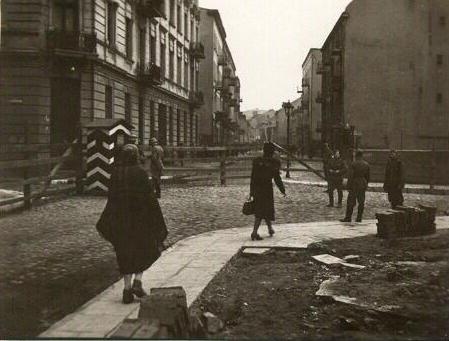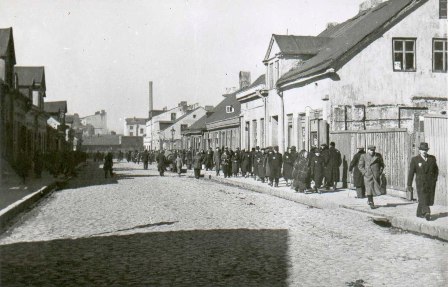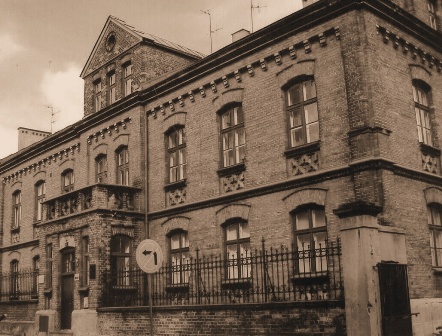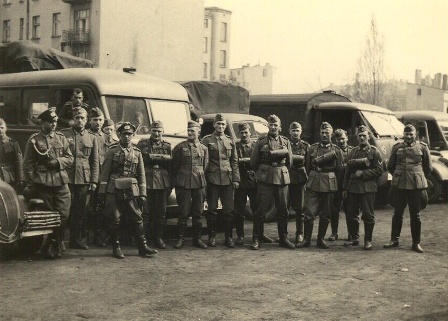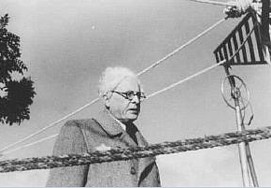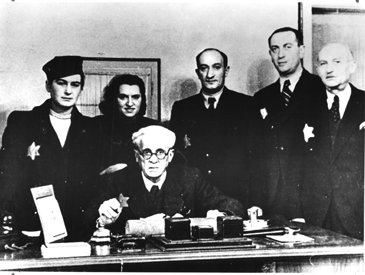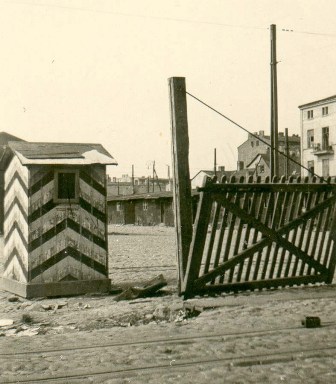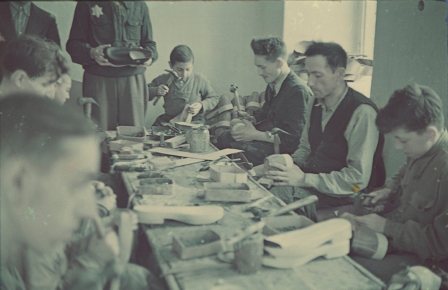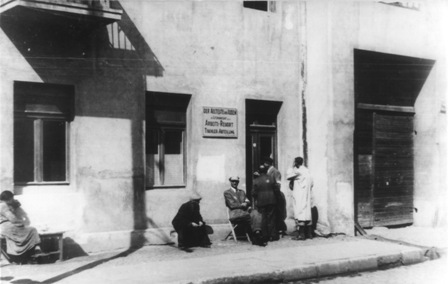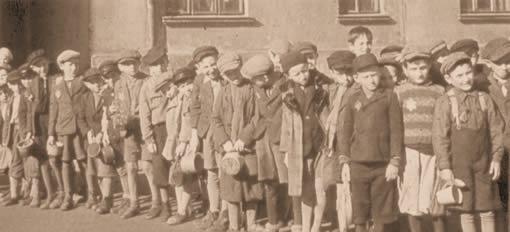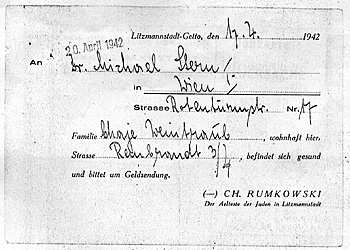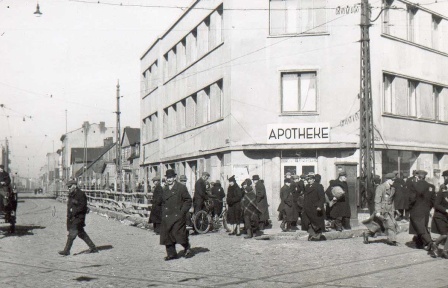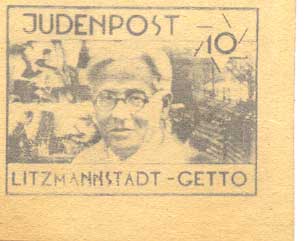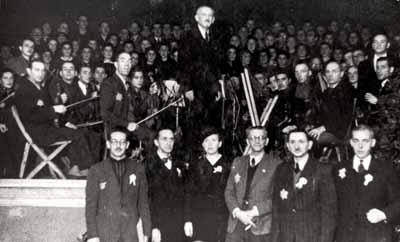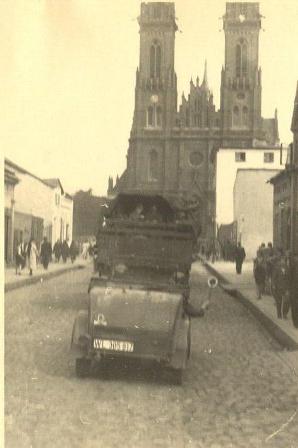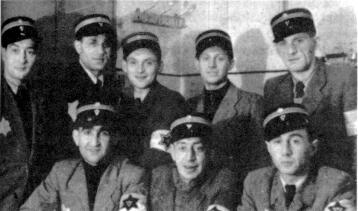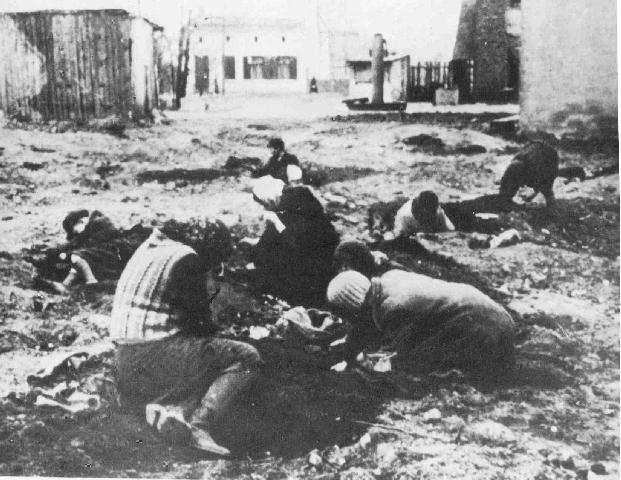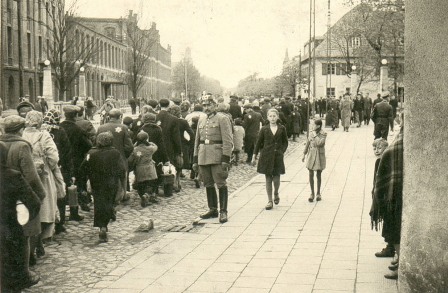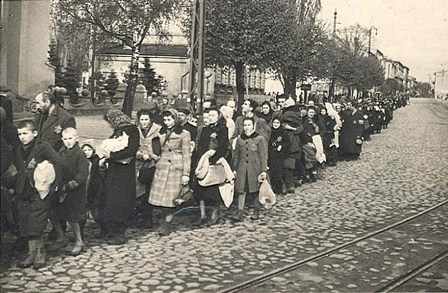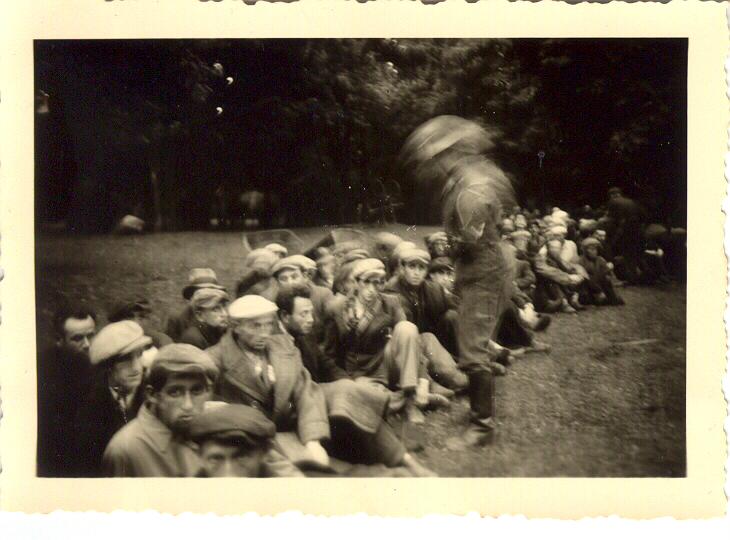Holocaust Education & Archive Research Team |
|
Ghettos The Lodz Ghetto Introduction to the Ghettos of the Holocaust
Jewish Ghettos The Judenrat Judenrat Leaders Prominent Jews
| ||||||||||||||||||||||||||||||||||||||||||||||||||||||||||||||||||||||||||||||||||||||||||||||||||||||||||||||||||||||||||||||||||||||||||||||||||||||||||||||||||||||||||||||||||||||||||||||||||||||||||||||||||||||||||||||||||||||||||||||||||||||||||||||||||||||||||||||||||||||||||||||||||||||||||||||||||||||||||||||||||||||||||||||||||||||||||||||||||||||||||||||||||||
The Lodz Ghetto 1940 - 1944
The First Months of Occupation
The persecution of Jews began soon after Lodz was occupied by the Germans on 8 September 1939. The racist Nuremburg Laws of September 1935 which the Nazis had applied to German, Austrian and Czech Jews, were immediately enforced.
From 9 November 1939, Lodz became under the authority of Gauleiter Artur Greiser, who was a resolute advocate of rapid and total Germanisation of the areas, under his command.
In a short time, together with his subordinate Friedrich Übelhör, President of the Kalisz- Lodz region, and Leister, Commissioner of Lodz, Greiser enacted a series of drastic decrees. The Jews of Lodz were subjected to legal restrictions and various orders and bans, many of which were applied for the first time, the laws introduced earlier in Germany, Austria and Czechoslovakia were made more rigorous in Lodz.
Chronologically the first discrimination measures directed against the Jews were orders of the Chief of Civil Administration, 8th Army, published on 18 September 1939, which restricted currency exchange and prohibited trade in leather and textile goods.
The inclusion of Lodz in the Reich intensified the legal terror against the Jews. New instructions constituted typically anti- Jewish legislation. The occupation authorities aimed at the complete separation of Jews from the general population, and limiting their freedom of movement.
The first of these regulations was announced on 31 October 1939 by the Chief of Police of Lodz – an order to mark every enterprise and shop with prominent signs indicating the owners nationality, which made the pillage of Jewish stores and workshops easier by the Germans.
On 14 November 1939 Friedrich Übelhör, announced additional restrictive measures:
“The Jews were to wear on their right arm, directly under the armpit, with no regard to age or sex, an 10cm wide band of Jewish yellow colour as a special sign. Those who violate this order are liable to face the death penalty”.
Übelhör also introduced a curfew, which prevented Jews from leaving their apartments from 5:00pm till 8:00am
Übelhör’s order to mark the Jews was the first of its kind enacted in the Third Reich having no basis in Nazi legislation. Heydrich’s decree concerning the marking of Jews in the Reich was published on 1 October 1941. It did not apply to children under the age of six, and violations were not punished by death, but with a fine of 150 RM or up to 6 weeks arrest.
Less than a month later that directive was amended with a decree published on 11 December 1939, by Artur Greiser the Gauleiter of the Wartheland , Jews were ordered to wear a yellow star of David on the chest and back instead of armbands.
Simultaneously, numerous restrictive police control measures were introduced. Jews were not allowed to walk along Piotrkowska Street or to enter city parks and forbidden to use public transportation. All Jewish workers employed in “Aryan” enterprises were to be dismissed.
Pillage of Jewish property proceeded on a wide scale. In the first days of the occupation the plunder was out of control. On the third day after Lodz had been occupied, armed soldiers and police began to invade Jewish apartments, workshops and stores. Many precious objects were stolen under the pretext of searching for weapons.
These robberies often ended with serious assaults on the owners. The process of plundering was actively pursued by the Germans living in Lodz , who chose to rob wealthier Jews of the best apartments and shops. Jews were often forced to pay a ransom during these actions.
A little later the military, administrative and economic authorities of Lodz began to pursue a policy of officially organised pillage. The military forces authorised the Association of Combing Mills as early as mid-September 1939 to make an inventory of textile raw materials owned by Jewish merchants, and to confiscate them. The plunder amounted to 1.8 million RM in goods.
A few days later on 29 September 1939, according to the degree enacted by the general commander of the Land Forces, all enterprises, workshops and real estate abandoned by their owners went into receivership.
On 1 November 1939 the military authorities rights regarding confiscation and selling of enterprises not belonging to German’s were transferred to the General Receivership Bureau East (Haupttreuhandstelle Ost) established in October 1939.
Pillage and confiscation of Jewish factories proceeded rapidly thereafter, and most confiscated raw materials were transferred to the Reich.
The expropriation of Jewish property in Lodz accelerated in November and December 1939. Raw materials, half –finished goods and products expropriation was from then on joined by the Lodz branch of General Bührmann’s office and the Lodz Trade Society established in the second half of November, which aimed at taking over all the goods in stock from Jewish merchants.
The Nazi authorities aimed at weakening the Jewish population by destroying its financial base. Thus, as well as the pillage of property, Jews were also ejected from economic life.
Harry von Craushaar, Chief of the Military Administration of the 8th Army on 18 September 1939, issued an order blocking all Jewish bank accounts, deposits and safes. Jews were not allowed to withdraw more than 500 zloty a week from their bank accounts, and no more than 250 zloty a week from their savings accounts. They were also forbidden to have no more than 2000 zloty at home.
On 13 October 1939 the same authority ordered all factory owners, shipping and transport companies and store owners to report all raw materials and goods produced after 10 September 1939, to the special receiver dealing with textile raw materials. All reported goods were confiscated, leaving the Jewish workshops and factories without raw materials for production.
Five days later on 18 October 1939, Jews were forbidden to trade in textile goods, leather goods and raw materials by order of the Border Guard Middle Section Commander. Failure to comply was subject to an unlimited fine, arrest or even the death penalty. As a result, Jewish handicrafts, which had flourished in Lodz were seriously undermined and eventually destroyed.
On 2 December 1939 the deputy president of Police issued an order which excluded Jews from work involving road transport, a restriction which prevented approximately a thousand Jews from earning a living.
Intellectuals, lawyers, teachers, artists and doctors were also ejected from economic life. The boycott of Jewish doctors forced 40 physicians who lived in the city centre, to move to the Jewish district – The Old Town – in January 1940.
The Jewish community were thus imprisoned in their own apartments by the above measures, and were thus prevented from supporting themselves. The Jews of Lodz, especially the poor, were left without means to survive.
Already from the first months of the occupation, constant round-ups of Jews in the streets became a massive danger. They were violently dragged from houses and streetcars and forced to do hard work by the Germans.
Jews began to hide in cellars and attics. They sat there from dawn to dusk, often for several days, in constant fear of being caught and assaulted. The streets in the Jewish districts stood empty.
To protect people from round-ups, the Jewish Congregation, who self-governed the Jewish community offered co-operation with the German authorities regarding recruiting workers. The offer was accepted and on 7 October 1939, a Labour Recruitment Office(Arbeitseinsatz 1) was established and located at 18 Pomorska Street – later at 10 Poludniowa Street.
The office delivered contingents of labourers to the occupation authorities. At first the authorities were supplied with 600 workers a day – later the number increased to 2000 a day. Jews received no payment for their work, although they were forced to do the heaviest labour. Until the ghetto was sealed off, tens of thousands suffered from the degradations accompanying forced labour.
From the very beginning of the occupation the Nazi authorities used terror against the Jewish population. Jewish politicians, social activists and intellectuals were seized according to lists prepared in advance, and imprisoned in a concentration camp created without delay in Glaser’s factory in Radogoszcz.
They were tortured and subsequently shot or transported to Dachau and Mauthausen concentration camps.
On 2 November 1939, the Germans executed in Lagiewniki Woods 15 men arrested a day earlier in the Astoria Café. Many others were savagely beaten and tortured. Ten days later on 10 November, two Poles and a Jew named Radner were hanged in public. Their bodies were left hanging for several days.
On the same night all four great synagogues of Lodz were blown up and burned, and on 11 November the Jewish Kehillah premises were surrounded and nearly all members of the Council of Elders were arrested. Of the 30 only 6 councillors were released – the rest were tortured and shot in Lagiewniki Woods.
Simultaneously with organised terror, numerous individual murders and “spontaneous” pogroms of the Jews were taking place. One pogrom took place on 8 October 1939, carried out by the local Germans on the occasion of Josef Goebbbels visit to Lodz.
In September 1939 thousands of Lodz Jews decided to become refugees, some managed to escape to Russia, others especially the wealthy ones, to neutral countries. Many Jews fled to the General-Government.
On 12 December 1939 the occupation forces commenced the deportations to the General- Government, to fulfil the Nazi plans of removing Jews and Poles from the territories annexed into the Reich. These actions were carried out with extreme cruelty and pillaging of property.
Many Jews were shot and many froze to death, according to estimates more than 71,000 Jews either left or were deported from Lodz, during the first few months of the occupation.
The Beginning of the “Closed District”
The policy of building ghettos was set out in a secret memorandum of 21 September 1939 by Reinhard Heydrich to the commanders of the SD Einsatzgruppen and other central offices of the Third Reich. The letter contained general instructions on solving the “Jewish question”, in two main stages.
The first stage was the concentration of all Jews in designated areas, the second stage followed the total annihilation, camouflaged under the term “final goal” (Endziel). Rumours regarding the creation of a ghetto spread through the city already at the end of September or the beginning of October 1939.
The official position was detailed in a confidential circular from Friedrich Übelhör, who wrote on 10 December 1939 that in view of the fact that a complete evacuation of Jews from Lodz was considered impractical at that moment in time, a ghetto would be established.
The location of the ghetto would be established in the northern part of the city, and this was completed by the beginning of February 1940.
The order to to establish an isolated district for Jews was announced by the Chief of Police Johann Schäfer in the Lodscher Zeitung on 8 February 1940. The notice contained a rough map of the ghetto, and a detailed plan for resettling Jews from other districts.
The ghetto was located in the most neglected part of northern Lodz – Baluty and the Old Town with an area of 4.13km. When the ghetto was first established, the streets that formed the boundaries were as follows:
Goplanska – Zurawia – Wspolna – Stefana – Okopowa – Czarnieckiego – Sukiennicza - Marysinska – Inflancka – along the Jewish cemetery walls, and then Bracka – Przemyslowa – Srodkowa – Glowackiego – Brzezinska – Oblegorska – Chlodna – Smugowa – Nad Lodka – Stodolnia – na – Podrzeczna – Drewnowska – Majowa – Wrzesnienska – Piwna – Urzednicza – to Zgierska and Goplanska.
A year later in May 1941, the German authorities separated the area limited by the streets Drewnowska, Majowa, and Jeneralska from the ghetto. As a result the ghetto border was moved eastwards and the ghetto area shrank to 3.82km.
Excluded from the ghetto area were Nowomiejska – Zgierska and Limanowskiego streets, cutting the ghetto into three parts. At first the traffic between them was directed through specially built gates, which were opened at certain hours.
However, traffic moved very slowly through the gates, and in the summer of 1940, three wooden bridges for pedestrians were erected over Zgierska Street near Podrzeczna Street and Lutomierska Street,and over Limanowskiego Street near Masarska Street.
The final enclosure of the ghetto and its total isolation from other parts of the city took place on 30 April 1940. Barriers and barbed wire entanglements were placed around the ghetto and along its two main isolated arteries – Nowomiejska and B. Limanowskiego.
Telephones in the ghetto could be used only by administration officers, and only for official matters. On 13 July 1940, conditions of the mail exchange between the ghetto and the outer world were established.
Only postcards were allowed, which had to be written clearly and in German – only personal news could be mentioned. Unofficial contacts between the Jews and the “Aryan” inhabitants of Lodz were made even more difficult by the fact that the city had a German minority of about 70,000, loyal to the new authorities.
Houses next to the ghetto were demolished. Baluty and the Old Town had no sewage system, so it was not possible to get out of the ghetto through sewage canals. These factors made the Lodz ghetto “tighter” and easier to guard than the other ghettos in the General – Government, with tragic consequences for the inhabitants of the ghetto, since smuggling food and medicines to the ghetto was virtually impossible.
According to official records from 12 June 1940, 160,320 Jews were enclosed in the ghetto, of whom 153,849 were former inhabitants of Lodz and 6471 came from the Warthegau area. A year and half later, between 17 October and 4 November 1941, 19722 Jews from Austria, Czechoslovakia, Luxemburg and Germany were deported to Lodz.
In the period between 7 December 1941 and 28 August 1942 , 17,826 Jews from the liquidated provincial ghettos in Warthegau (Wloclawek, Glowno, Ozorkow, Strykow, Lask, Pabiance, Wielun, Sieradz, Zdunska Wola) were deposited in the ghetto.
In sum, more than 200,000 Jews from Warthegau and Western Europe went through the Lodz ghetto. Two isolated camps for Gypsies – Zigeunerlager and for Polish youths – Polenjugendverwahrlager – were placed within the ghetto area.
The 5007 Gypsies from the Austrian – Hungarian border( Burgenland) were transported to Lodz between 5 and 9 November 1941. A camp was established for them in the quarter of Brzezinska, Towianskiego, Starosikawska and Glowackiego Streets.
Sanitary conditions were tragic, resulting in approximately 600 deaths from typhus and other diseases. The Gypsy camp existed until 16 January 1942, when its inhabitants were transported to the death camp at Chelmno on the Ner.
The camp for Polish youth and children, located at Przemyslowa Street, began functioning on 1 December 1942. Inmates were children between the ages of 8 –16, whose parents were in camps or prisons, children from orphanages, educational institutions, and homeless children. A large group of prisoners were minors accused of co-operation with the resistance movement, illegal trade, refusal to work and petty thefts.
In the years 1943/44, the camp held was 1086 boys and about 250 girls. Conditions in the camp were unhealthy, weakening the young bodies. The food rations were below starvation level, as in concentration camps.
All children over the age of 8 were forced to work 10-12 hours a day. Many children died of hunger, diseases, and from beatings administered by German guards. The camp existed until the liberation of the city.
German Police in the Ghetto
The Gestapo had the leading role in supervising the ghetto and in the subsequent liquidation of its inhabitants. Since the end of 1941 the Gestapo had functioned as a unit carrying out orders of the Main Security Office (RSHA) regarding the final solution of the “Jewish question”.
The Gestapo post in the ghetto was opened at the end of April 1940, in two rooms of a building at the corner of Limanowskiego and Zgierska Streets, occupied by the 6th Schupo District.
Personnel consisted of officers from the Jewish Department of the Lodz Gestapo marked with the symbol llB4, later IV4b.
The Gestapo post participated with the criminal police station of the ghetto in pillaging Jewish property. The Police station was located in a parish building at 8 and 10 Koscielna Street, known in the ghetto as the “Red House”.
In the first period of the ghetto’s existence the criminal police was to fight smuggling and the black market, later a basic task was to discover and confiscate the ghetto inhabitants belongings.
The Police station – The Red House – evoked terrible fear among the Jews. In its cellars information about hidden property was obtained with the use of sophisticated torture. Many of the tortured people died, others became cripples.
The 6th Schupo District was also located in the ghetto, in the same reinforced building occupied by the Gestapo at the corner of Limanowskiego and Zgierska Street.
Schupo posts located every 50 to 100 meters guarded the ghetto borders. Additionally at strategic points sentry boxes were located at intersections of streets – l - Drewnowska and Zachodnia, II – Kilinskiego and Smugowa, III – Sporna and Boya, IV- Inflancka and Zagajnikowa , V- Okopowka and Franciszkanska.
Soldiers from special battalions stood guard. The main task of the Schupo was to keep order within the ghetto. The policemen together with Gestapo officers searched new arrivals in the ghetto and confiscated their belongings, especially jewellery and hard currency. The members of the Schupo were particularly brutal and used their weapons frequently.
German Management
Administratively, the ghetto was subordinated to the City Board. At first the Mayor – Karol Marder separated a branch office from the City Board Economy and Food Supplies Department.
It was located at 11 Cegielniana Street – its manager until 5 May 1940 was Johann Moldenhauer, later that function was taken over by Hans Biebow, a commissioned merchant from Bremen.
On 10 October 1940 the branch office was changed into an independent department of the City Board under the name of Gettoverwaltung (the Ghetto Management). The office reported directly to Oberbürgermeister Werner Ventzki.
At first, the main task of the Gettoverwaltung was to supply the ghetto with food and medicines, and to administer financial transactions between the Jewish district and the city. After October 1940 the office managed the process of transforming the ghetto into a labour camp, taking over its inhabitants property, supervising the exploitation of the labour force.
Beginning in January 1942 Hans Biebow, and his deputies Joseph Hammerle and Wilhelm Ribbe participated in the selection of people brought from the liquidated provincial ghettos and in deportations from the Lodz ghetto to the death camps.
Soon Hans Biebow came to be appreciated by the central and Warthegau authorities. He performed well with his murderous exploitation of the ghetto’s labour force, and by imposing the idea of financial self-sufficiency of the ghetto.
Using his many years of business experience, Hans Biebow became comfortable and widely accessible to the local bosses as a dispatcher of robbed Jewish goods. Biebow sold valuable objects at considerably lower prices, and sent gifts to dignitaries, such as Artur Greiser.
These activities enlarged the circle of his protectors and allowed him to exercise almost absolute authority over the Lodz ghetto. The ghetto management team developed rapidly from only 24 employees in May 1940, to 216 clerks, officials and workers by the middle of 1942.
Jewish Administration
The Jewish administrative body – the so-called Ältestenrat [Council of Elders] reported to the Gettoverwaltung officials. It was particularly well-developed in Lodz, because the ghetto economy was extremely centralised.
In contrast with other ghettos in Poland, private enterprises were not allowed in the Lodz ghetto. The head of the Jewish administration carried the title of the Eldest of the Jews in Litzmannstadt Ghetto.
Note: Litzmannstadt was the name the Germans gave to "now German" Lodz.
The occupation authorities appointed Chaim Morderchaj Rumkowski to the position on 13 September 1939. The Council of Elders appointed by him was to perform the role of an advisory body, but in reality played no role at all.
Rumkowski became the main go-between for the Jewish administration and the German authorities. The Germans forced him to co-operate in transforming the ghetto into a labour camp and in stealing its inhabitant’s belongings using blackmail threats of further reductions in food supplies for the ghetto.
Rumkowski was given a great deal of independence in the inner organisation of the ghetto. He had authority in police and judicial matters, including the right to arrest and send people to prison. He managed the economy and the administration. He was also entitled to create new offices, departments, labour workshops and various agencies.
The structure of the Jewish administration in the Lodz ghetto differed from the usual administration systems. The administration consisted of departments, headquarters, workshops and various posts, which constituted independent agencies with various degrees of competence.
Some were liquidated, some were created or reactivated, some were transformed in response to actual needs. In the years 1940 –1944, the administration numbered from 27 to 32 agencies, with 13 to 14 thousand employees.
Chaim Rumkowski managed this complex structure through the Central Secretariat commonly called the “The Headquarters”, which was located, as were most of the important agencies, in buildings and barracks at Balucki Rynek (Baluty Marketplace). The Rynek was separated from the rest of the ghetto and provided place of contact with the German management of the ghetto.
All supplies were delivered and unloaded a this location.
From there, stolen Jewish belongings and part of the labour workshops production were transported out. Only persons with special passes and those employed there were allowed to enter the square.
The “Headquarters” opened 7 May 1940. Rumkowski was assisted by Dora Fuchs, who exercised her duties without interruption, until the liquidation of the ghetto in August 1944.
Apart from handling current correspondence among the ghetto departments and workshops and with the authorities, the Headquarters had additional functions: it gathered reports on the activity of each agency, completed and kept Rumkowski orders and circulars; was instrumental in handing over to the Gettoverwaltung the stolen Jewish belongings: and dealt with all cemetery matters.
Several departments reported to the Headquarters. Most important was the Presidential Department, also called the Presidential Secretariat, originally located at 4 Plac Koscielny and subsequently at 1 Dworska Street. The Department prepared reports, edited and published Rumkowski’s circulars and orders, distributed passes and food coupons, and issued identity cards.
Other important organisational units of the Headquarters included the Personnel Department at 4 Dworska Street, dealing with employment issues, and the Main Treasury at 4 Plac Koscielny, and Central Book-Keeping at 1 Dworska Street.
From 1 October 1940 Balucki Rynek was also the location of the Central Office of Labour Workshops, directed by commissioner Aron Jakubowicz. This unit managed all production matters in the ghetto and employment in the workshops. Specifically the office acted as an intermediary between the German management of the ghetto and the workshops when carrying out orders.
More than 90% of production was on orders from state authorities – mainly military and police, and paramilitary organisations. The largest consumers of uniforms, coats sheepskin coats, warm jackets, caps, shoes, straw boots, knapsacks, rucksacks etc were the Wehrmacht – Beschaffungsamt in Berlin, Heeresbekleidungsamt in Berlin, and its branch office in Poznan, Marinebekleidungsamt in Kiel and Wilhelmshaven, Polizeibekleidungsamt in Poznan and the Poznan branch of Organisation Todt.
Ghetto production was supervised by the Armed Inspection of the XXI Military District in Poznan and the Arms Headquarters in Lodz.
Approximately 10% of the ghetto’s production was for orders by famous department stores and private enterprises. The customers included:
· They were the main consumers of underwear, clothing, footwear, bags, textiles, furniture, lamps, lampshades etc. State and private orders in 1944 were completed by 114 factories and workshops, which employed nearly 70,000 workers. A profit of 2.2 million Reichsmarks was realised as a result of these goods being produced.
The largest producers and their premises were as follows:
· Tailor workshops – headquarters at 45 Lagiewincka Street · Shoemaking workshop – 27 Franciszkanska Street · Straw Products workshop – 79 Brzezinska Street · Metal Products workshop – 63 Lagiewincka Street · Carpentry Woekshop – 12 Drukarska Street · Rubber Products workshop – 9 Zgierska Street · Textile Workshop – 77 Drewnowska Street
Health Department
This department was created as early as 16 October 1939, its location in the Ghetto was the building of National Health Service Hospital at 34/36 Lagiewnicka Street. The Health Department was directed in succession by Dr Dawid Helman, Dr Leon Szykier, and Dr Witkor Millier.
Thanks to their efforts and with considerable help from a large group of doctors, they managed to organise an efficient health service. At the height of its development the ghetto had 7 hospitals, 7 pharmacies, 4 clinics, 2 emergency stations, 2 preventative clinics for children and 2 nursing homes for the elderly.
120 doctors worked in the hospitals at:
The hospitals functioned till mid-September 1942 – they contained in total 2600 places for patients. About 10 to 12 thousand patients went through the hospitals per month, the four clinics serviced about 6000 patients a month.
The Jewish health service constantly fought epidemics and gave medical help to tens of thousands Jews, and hundreds of Gypsies, imprisoned in the camp within the ghetto, and to Polish children from the camp at Przemyslowa Street. The results of the health service’s work were negated because of lack of food and medicines.
The ghetto hospitals were liquidated on 15 September 1942 after the so-called – Allgemeine Gehsperre – the patients were either murdered in the hospitals or deported to the death camp at Chelmno, and the hospitals were turned into workshops.
At the end of 1942, with the consent of the occupation authorities, two new hospitals were created – a surgical one at 7 Mickiewicza Street and an isolation one at 74 Dworska Street.
The Education Department
The Education Department was established by Chaim M Rumkowski in October 1939 at 27 Franciszkanska Street.
Elijahu Tabaksblat was appointed director and in a short time a number of primary and secondary was created.
In the year 1940/1941 the Lodz ghetto had 36 primary schools, 4 religious schools, 2 special schools, 2 grammar schools and one musical school. The schools were attended by about 14,800 pupils.
All schools had their own canteens and health care, which was free for poor children. The Education Department also organised two-week summer camps at Marysin for 10,000 children and youths.
In October 1941, the Education Department and the schools ceased to function when 20,000 Jews from Western Europe were resettled in the Ghetto. The school buildings were inhabited by Jews from Prague, Vienna, Berlin, Luxemburg and Frankfurt.
From then on the education of children and youths was conducted partly in secret and in a limited form within the official programme of professional training for workers.
The Supplies Department
The Supplies Department was located at Balucki Rynek and began work in May 1940 under the management of H. Szczesliwy. The main tasks of this department included distribution of food, fuel and medicines received from the German authorities.
It was administered according to the issue of a coupon system.
The department was divided into 7 sections:
The Kitchen Section and Food Coupon Section tried to fight starvation in the ghetto by establishing 462 cheap public canteens, and from January 1941 73 municipal and communal canteens. These measures managed to keep alive many of the ghetto inhabitants despite a constant lack of food.
Thanks to the rationed distribution of food the rate of deaths caused by starvation was 50% lower in Lodz than in the Warsaw ghetto, which was much wealthier and supported by smuggling.
The Accommodation Department
The Accommodation Department was established on 26 January 1940. It was initially managed by Henryk Naftalin, later its head was Baruch Praszkier. The department was located at 11 Lutomierska Street, later at 10/12 Rybna Street. It dealt with allocating flats to people resettled in the ghetto.
The Registration Department
The Registration Department at 4 Miodowa Street – later 4/6 Plac Koscielny functioned from 10 May 1940. After January 1941 the office was connected with the Registry and the Statistics Department, managed by Henryk Naftalin.
The office’s task was registering the inhabitants, keeping up to date records and a current index of accommodation and addresses. Later, in 1941 the office began keeping record books of births, marriages and deaths and statistics of population movements within the ghetto.
An additional function of that department was to provide addresses of ghetto inhabitants to the ghetto administration and to the German authorities.
The Rabbinical College
The Rabbinical College under the leadership of rabbi Szlomo Trajstman functioned until mid-September 1942, until the office was closed by the occupation authorities. The rabbis were sent to work in various administration agencies.
The College was located in a building at 4 Plac Koscielny. Rabbinical decisions on religious matters and rituals like marriages, divorces, circumcisions were among the responsibilities of the College.
On 17 July 1940 Rumkowski appointed the Rabbinical College a civil institution in order to co-operate with the Registration Department.
The Bank of Issue
The Bank of Issue was established on 26 June 1940, as ordered by Friedrich Übelhör. Pinchas Gierszowski was appointed managing director.
The bank was located at 71 Maryinska Street, and the branch opened on 8 July 1940, at 56 Limanowskiego Street.
The Bank printed and supervised distribution of the ghetto currency- Markquittungen – commonly called “rumki” after Rumkowski.
Rumki became the only legal tender in the Jewish quarter, this was another measure intended to block illegal trade with the “Aryan” part of the city. The Bank also controlled rates of exchange for German and foreign currency and ghetto notes.
The Bank for Purchasing Valuable Objects and Clothing
The Bank for Purchasing Valuable Objects and Clothing was established on 12 August 1940. It was located at 7 Ciesielska Street and its president was L. Szyffer. The bank purchased German marks, foreign currency, golden coins, jewellery, carpets, fur coats, clothes, postage stamps, collections and paintings from the ghetto inhabitants.
The Post Office
The post office in the ghetto opened on 15 March 1940 at 4/6 Koscielny. Three weeks later, on 4 April, an additional branch and a parcel section began functioning at 1 Dworska Street. The mail exchange took place in a special barrack at Balucki Rynek. The Ghetto mail service was managed, in succession, by Herbert Grawe, Maurycy Goldblum, Jakub Dawidowicz and Mosze Gumener.
Despite considerable limitations and censorship the postal service provided the opportunity for contacts between the ghetto and the outside world. Through its doors went the correspondence, parcels, and postal orders from occupied Poland and from abroad.
The post office also carried out all deliveries of private and official correspondence in the ghetto, using its own postage steps worth 5, 10 and 20 ghetto marks, only for the internal service.
The Ghetto Trams Department
The Ghetto Trams Department was created in August 1941 in cooperation with the Municipal Tramways Enterprise. Wladyslaw Dawidowicz and Leopold Szreter were appointed as directors.
In May 1943, the department merged with the Transportation Department, located at 7 Dworska Street under the direction of Marian Kleiman. Between October 1941 and March 1942, a tram line was built from Brzezinska Street through Marysinska and Jagiellonska Street to the railway ramp Lodz – Radogoszcz.
Simultaneously several side tracks were built from Franciszkanska to Jakuba Street and at 1/3, 32, 45, 63 Lagiewnicka Street, which connected the most important labour workshops and the railway station at Radogoszcz.
The trams in the ghetto were used initially for the transportation of goods, raw materials food and fuel. The first passenger cars first saw service in the second half of 1943 to transport people working at the Marysin labour workshops between the hours of 06:00- 07:30 and 18:30 –19:00
The Welfare Department
The Welfare Department at 20 Dworska Street and the Community Centre at 3 Krawiecka Street are worth mentioning.
The last one performed an important role in keeping up the spirits of the ghetto’s inhabitants. Music concerts were performed, by a symphonic orchestra, under the direction of the famous conductor Teodor Ryder.
The popular music programs and the amateur revue theatre were directed by Dawid Bajgelmam, Bronislawa Rotsztajtowna, a famous violin player and the tenor Nikodem Sztajman held recitals there.
An important role in fighting crime and ensuring peace and order in the Lodz Ghetto was undertaken by the High Chamber of Control, the Jewish police and the administration of justice.
The High Chamber of Control
The High Chamber of Control was established on 6 November 1940. Its first location was a building at 1 Dworska Street, later at 25 Lagiewnicka Street. It was directed by a presidium of 4 members, with Jozef Rumlowski as chairman.
The Chamber was charged with fighting offences and crimes of all kinds, and prevention of potential corrupt practices. As such the Chamber controlled the activities of all departments, administration agencies and associations, was entitled to remove clerks from their posts and to search people, their houses and offices.
The Chamber also had the right of temporary arrest of suspects until the decision on their cases was made by the Superior of the Elders Council or by the court. The Chamber was liquidated on 12 November 1942.
Courts and the Public Prosecutors Office
Chaim Rumkowski established this office on 18 September 1940, and it was headed by Stanislaw Jackobson, and its location was at 20 and 22 Gnieznienska Street.
Sentences were passed according to the rules of civil and criminal procedure enacted by the ghetto lawyers.
On 11 March 1941 Rumkowski appointed the Summary Court, which was located at 27 Franciszkanska Street. Rumkowski also empowered himself to pass sentences without the participation of the prosecutor and defence.
The sentence was passed by a judge in the presence of two assessors, without a right of appeal.
A juvenile court operated at 13 Lutomierska Street.
Persons sentenced by the court were transported to the Central Prison located in a block of buildings at 6-18 Czarneckiego Street.
During the resettlement period the prison functioned as a transit camp, from where people were transported under escort to the railway ramp at Radogoszcz.
The Jewish Police
The Jewish Police (Ordnungsdienst) was created by Chaim Rumkowski on 1 May 1940.
Their headquarters was located at 1 Lutomierska Street and the commander was Leon Rozenblat.
The ghetto police which numbered about 1,200 men in 1943, was charged with keeping order in the ghetto, fighting the black market and taking part in the deportations of the ghetto inhabitants to death camps.
The area of the ghetto was divided into five districts with police stations as follows:
· I – 27 Franciszkanska Street · II – 56 Aleksandrowska Street · III – 61 Lagiewnicka Street · IV – 69 Marysinska Street · V – 36 Zagajnikowa Street
The ghetto also had a Special Section of the Jewish police whose headquarters was at 96 Lagiewnicka Street, which assisted the Germans in pillaging Jewish property.
The Commanders of the Special Section were Dawid Gertler and Marek Kligier.
Starvation and Diseases
The most grievous form of the indirect extermination of the ghetto inhabitants was starvation. In 1940, the daily caloric ration in the ghetto was equal that for regular prisoners – about 1800 kcal. By mid-1942 the ration fluctuated about 600 kcal.
The caloric deficit increased from 40% to 80%, which in practice appeared as a feeling of constant hunger and subsequent wasting away, famine tremors and death from starvation.
The death rate due to starvation increased in geometric progression. In 1940, starvation was the cause of only 206 deaths, but in 1942 2811 people died from starvation. In other words, a 10-fold increase.
In subsequent years starvation was still the direct cause of 18% of all deaths
The general weakening of the body caused by starvation added to the danger of contracting diseases.
Tuberculosis increased rapidly due to a lack of vitamins and malnutrition. Officially, TB was discovered in 20% of the population, but as many as 60% of the ghetto inhabitants may have been infected.
In 1940 589 persons died of tuberculosis – in 1942 this had risen to 2182 persons. In the final days of the ghetto in 1944 tuberculosis was the cause of 39% of all deaths.
Altogether 7269 persons died from TB in the Lodz ghetto.
Other contagious diseases were widespread also. An epidemic of dysentery broke out in 1940, which killed 1117 persons of the several thousands infected. As many as 6431 ghetto inhabitants contracted typhus- 320 died.
The proportion of patients with diphtheria, diarrhoea, scarlet fever, trachoma, and meningitis was three times higher than in the years between the wars.
Starvation, heavy labour, uncertain future and constant fear of deportation had a great impact on the increase in the number of heart and circulatory system diseases.
These were the most often cause of death until 1942. in mid-1942 3066 persons died from cardiovascular disorders.
The death rate was particularly high among Jews from Western Europe. Often elderly and formerly wealthy, these people quickly lost their strength and health under the extremely hard conditions in the ghetto.
During only 7 months of their stay in the ghetto between October 1941 and May 1942, 3418 Western Jews died.
The number of births decreased considerably in the ghetto. Many children were stillborn. Within the entire period of the ghetto’s existence only 2306 children were born, less than any single year before the war.
Number of the deceased in the Lodz Ghetto 1940 -1944
Terror and Extermination
Ten days after the ghetto had been sealed off, a draconian directive was enacted by the police chief of Lodz on 10 May 1941.
From that day, the use of weapons without warning was permitted against any Jew trying to leave the ghetto area.
That instruction became the basis for “legal” hunting of Jews who approached the ghetto fence. From numerous eyewitness accounts people were occasionally shot for “sport” or from boredom.
Other incidents involved the use of weapons in the context of the so-called control of window black-outs. The windows of Jewish flats were directly shot at, supposedly as a punishment for a light being visible from the street.
A common event was also “hunting for humans” organised by German officers – shooting casual passers- by without any provocation. The statistical reports in the files of the Head of the Council of Elders in the Lodz ghetto, and in the periodical reports of the criminal police indicate that:
The Nazis carried out public executions in order to intimidate the Jews. In 1942 two such executions took place at the Plac Bazarowy. On 21 February 1942 Maks Hertz, a fugitive from Cologne was hanged.
On 7 September 1942 the Nazis hanged 17 Jews deported in August 1942 from Pabiance. They were accused of resistance against the German authorities.
In March 1940 and July 1941 the mentally ill from the hospital at Wesola Street were murdered and many handicapped people fell victim to the Germans.
The Germans carried out the most destructive of actions against the ghetto inhabitants during the Allgemeine Gehsperre between 5 -12 September 1942.
In Rumkowski’s speech on 4 September 1942 the Chairman announced, “that by order of the authorities, about 25,000 Jews under the age of 10 and over 65 must be resettled out of the ghetto”.
The children, the elderly, the sick from the hospitals were loaded into 5-ton trucks which transported the Jews to a railroad station outside Lodz. The actual number deported was lower than the figure quoted in Rumkowski’s speech, 15,681 children and elderly people were deported from the Lodz ghetto.
The victims were loaded onto railroad cars and sent via Kutno to Kolo, from whence they were taken to the death camp at Chelmno, where they were gassed in specially constructed, stationary gas-vans.
The genocide of the Jews from Lodz began on the 16 January 1942 with the first transport of Jews sent to the death camp in Chelmno. The action lasted with breaks until the 15 May 1942.
57064 Jews from the Lodz ghetto, including 10943 Jews from Western Europe were gassed at the Chelmno camp. The Jewish victims were described by the Nazis as “dole-takers”, traders and criminals.
By the autumn of 1942 72,745 people, defined as “dispensable non-working element “ had been exterminated – and thus the ghetto had been transformed into a labour camp.
Deportations to the Chelmno death camp began anew in the middle of June 1944. The liquidation of the ghetto was ordered by Heinrich Himmler supposedly as early as the beginning of May 1944.
Albert Speer who was interested in war production in the ghetto, argued against its destruction. Yet he was not supported by Artur Greiser, and the liquidation went ahead.
Between 23 June 1944 and 14 July 1944, ten transports with 7196 people departed from Lodz to the death camp at Chelmno. Supposedly as a result of Albert Speer’s intervention with Adolf Hitler, the liquidation action was ceased on the 15 July 1944.
When the Warsaw uprising erupted on 1 August 1944 , Chaim Rumkowski was notified about the resumption of the evacuation of the Jewish people to the ‘Altreich’.
The appeals of Rumkowski, and the German authorities for volunteers willing to go the Reich went unheeded – only a few dozen people went to the gathering points.
The German authorities began blocking the streets and organising round-ups – this action lasted 20 days.
On 29 August 1944 the last transport of Jews departed from Lodz to the concentration camp at Auschwitz. Most of the deported were murdered in the gas chambers of Birkenau.
The Lodz ghetto which still numbered over 72,000 inhabitants in August 1944 ceased to exist.
Only a cleaning –commando and a handful of people in hiding numbering 20 –30 people remained. About 600 people were kept for a short time in collection camps at 36 and 63 Lagiewnicka Street. Those people included Aron Jakubowicz and Marek Kligier, with their families, a large group of physicians, engineers, artisans, and employees from Balucki Rynek.
These people were selected by Hans Biebow himself to be sent to labour camps in Konigswustenhausen near Berlin and to factories in Dresden.
Chaim Mordechai Rumkowski and his family were transported to Auschwitz-Birkenau on 28 August 1944 and murdered.
Liquidation of the Jewish Population – Lodz Ghetto
* Note – About 72,000 Jews were deported to Auschwitz – Birkenau at that time. From that number 5 to 7,000 survived according to Szmuel Krakowski.
Sources:
The Lodz Ghetto 1940 -1944 – Vademecum – Archiwum Panstwowe W Lodz & Bilbo – Lodz 1999
The Chronicle of the Lodz Ghetto 1941-1944 edited by Lucjan Dobroszycki published by Yale University Press New Haven and London. 1984
Alphabetical Index of Street Names in the Lodz Ghetto
Dedicated to Arek Hersh (Herszlikowicz)
"Born in Sieradz, Poland in 1928. At the age of 11 he was sent to a slave labour camp at Otoczno, near Arek was liberated in Theresienstadt on 8 May 1945."
Sources:
The Chronicle of the Lodz Ghetto 1941-1944 edited by Lucjan Dobroszycki published by Yale University Press New Haven and London. 1984 PRO NARA USHMM
Copyright SJ H.E.A.R.T 2007
|
